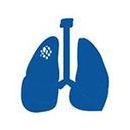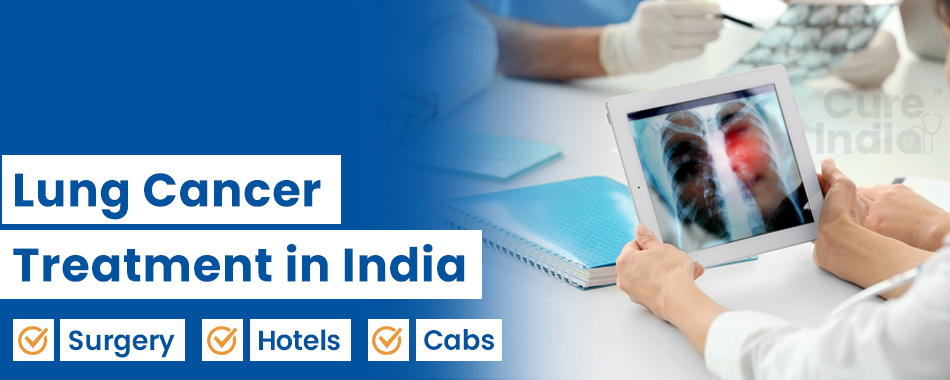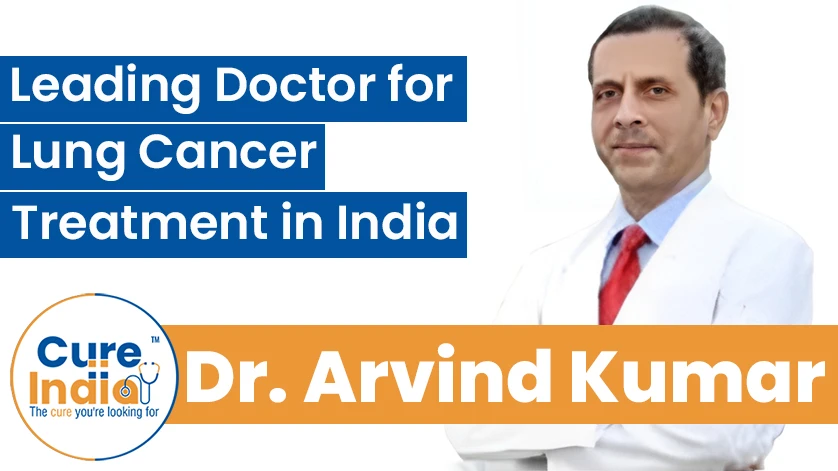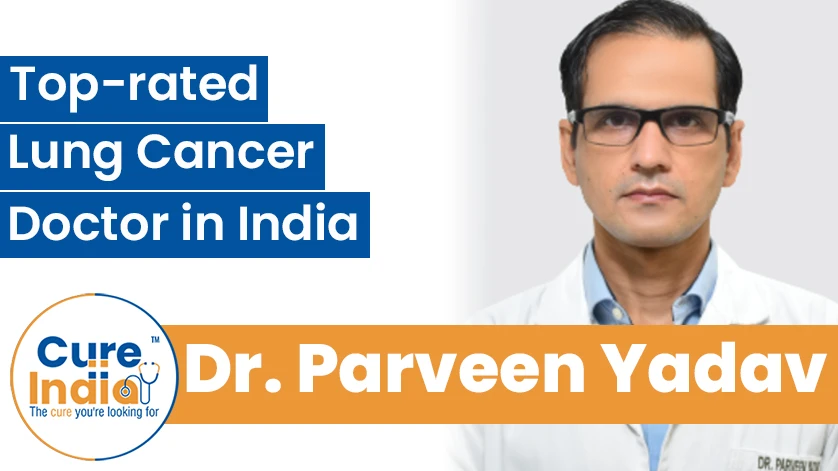

Cancer is a disease caused when the normal cells become abnormal due to a mutation in the genetic material (DNA) present in those cells. There are many types of cancer named by the location or an organ of the body where it starts from. For example, if the cancer has developed in the prostate gland or breast, we call it prostate cancer and breast cancer respectively. Similarly, when cancer develops in the lungs, we call it lung cancer.
The cancer that starts in the lungs is known as primary lung cancer. However, sometimes the cancer begins from any other part of the body and then spreads to the lungs. If this is the case then it is known as secondary lung cancer or metastatic cancer in the lungs. Lung cancer is the second most common cancer worldwide. It is the leading cause of cancer death all around the globe. Studies show that there were 2.2 million new lung cancer cases reported in the year 2020. It is more common in men as compared to women.
In Africa, lung cancer is the 5th leading cause of death. About 1.1 million new lung cancer cases were reported in Africa in the year 2020. The studies show that, if proper action is not taken, then the cases of lung cancer in Africa will rise to 2.1 million cases with 1.4 million deaths by the year 2040. African countries like Ghana have reported that the cancer of the lungs is the 3rd most common cancer in men and Ethiopia has an incidence rate of 1.9%.
With the increasing cases of lung cancer, the diagnostic and therapeutic facilities and resources are inadequate in many African countries making it difficult to provide the medical care that the people need. In addition, there is a shortage of healthcare providers in these countries due to a lack of proper training for healthcare providers and low patient awareness.
It is due to this reason that many African lung cancer patients decide to travel to other countries for the proper diagnosis and treatment options. Medical care in developed countries is costly. On top of that, the travel and stay costs are also added making it highly unaffordable to receive the medical care in these countries.
However, in India, the treatment cost along with the travel and stay costs can be covered with just a fraction of the cost of only the treatment in developed countries. That is why, anyone can get a super affordable option to get medical care from India. In addition, the quality of healthcare service in India is world-class with the most experienced and skilled healthcare providers. The Indian lung cancer hospitals have the latest technology and state-of-the-art infrastructure which makes it a luxurious treatment experience at a meager cost.

Actually, there are many types of cancer that affect the lungs. We call all of them lung cancer because it is easier to pronounce and understand. There are two main types of lung cancer which are again of different types. The different lung cancer types are listed below.
The SCLC is a type of cancer that grows faster and is often harder to treat as compared to other lung cancer types. It mostly affects the people who smoke a lot. Small cell lung cancers are also sometimes known as neuroendocrine tumors which occur in the neuroendocrine system. The origin of the SCLC is neuroendocrine cells that are present in the lungs.
The NSCLC is the most common type of cancer of the lungs. About 80% of people diagnosed with lung cancer have this type. It is further divided into three types.
There are some other uncommon cancers related to the lungs. These are very rare but still possible to get one. These cancers include Adenoid Cystic Carcinomas, Lung Carcinoid Tumors, Lymphomas, Sarcomas, Hamartomas, etc. Some of the cancers are not really a cancer that starts in the lungs. There are many cancers that start in the other organs such as the Breast, Kidney, Pancreas, Skin, etc. Then, they spread to the other different organs one of them being the lungs. These are known as metastatic cancer to the lungs or secondary lung cancer.
Most cancers have different stages according to the size of the tumor It forms and whether it has spread to other parts of the body such as the surrounding tissues, the lymph nodes, bone marrow, the liver, etc. Based on this, the different stages of lung cancer are as follows.
Sometimes, lung cancer does not cause any symptoms unless a chest X-ray is done to visualise the lungs. But if you have the following symptoms, it is recommended that you get a chest X-ray done after consulting with your doctor. Following are the common lung cancer symptoms listed below.
If the cancer spreads from the lungs to the different other organs of the body, then you may have some additional symptoms at the site where the cancer has spread. For example,
The normal cells have a limited lifespan. Once their role in the body is over, they become senescent (stop dividing) and then they die (apoptosis). But when the cell becomes cancerous, the cells keep on dividing and they don’t die either. This happens when there is a mutation (change) in the DNA (genetic material) of the cell. Hence, the cancer cells are the normal cells that have changed DNA (mutated DNA) that keeps the cell multiplying.
These cancer cells can travel in the body through the blood or the lymph nodes and then establish in the other organs of the body. The exact reason why some people get lung cancer disease while some people don’t is not yet known. However, it is reported that people who have a habit of smoking and consuming tobacco products have a higher risk of damaging the DNA of the cells and causing lung cancer. About 70% of lung cancer is caused by smoking. Some of the other factors that can cause lung cancer are listed below.
The first step your doctor does after diagnosing you with lung cancer is to determine the starting point of the cancer. A lot of times it happens that the cancer has started in the lymph nodes but then it spreads to the lungs. In this case, the cancer is still known as lymphoma (cancer of the lymph nodes). Only if the cancer starts in the lungs and spreads to other parts of the body, it is known as lung cancer.
As you tell them about your symptoms to your doctor, he/she may also take into consideration your medical history, family history, your overall health, etc. First, your doctor will do a physical exam and then recommend some tests to confirm cancer and the extent of cancer. There are many tests available to diagnose cancer. Following are the diagnostic tests that can help your doctor diagnose cancer and plan your treatment.
Imaging tests such as Ultrasound, CT Scan, MRI Scan, PET Scan, bone scan, etc. are used to see where the cancer cells are present and whether they have spread to the other body parts or not. These tests create images of the internal organs of the body. The doctor uses these images to visualize any abnormalities and damages present in particular organs. While some of these imaging techniques show normal images, a few show a detailed view. Some can even create a 3D view of the organs.
In this method, the substance known as a tracer is injected into the veins of a patient. It will get collected in the different areas of the bone. A special camera is used to visualize the tracer. The normal and healthy bones appear lighter in the camera whereas the damaged or injured bones will appear different. They stand out when visualized in the camera.
The biopsy requires a small tissue sample of the affected area to examine under the microscope. After taking the sample of the patient’s affected organ, it is sent to the laboratory for testing. The pathologist visualizes the sample under the microscope and differentiates the cancerous and normal cells.
This diagnostic method is performed by experts known as a pulmonologist. The Pulmonologists are the doctors who are lung specialists. To perform this test, the pulmonologist first passes a flexible, thin tube that has an attached light from the patient’s mouth and moves it to the lungs through the windpipe. The tube helps the doctor in viewing the internal parts of the patient’s lungs. It can also be used to collect samples of the lung tissue or the fluids that can be further sent to the lab for testing.
It is a procedure that requires the patient to be asleep during the procedure. Once the patient is asleep, the surgeon makes a small cut/incision on the chest and inserts a medical instrument through this cut to examine the internal organs of the chest. This procedure can also be called a video-assisted thoracoscopy or a robotic-assisted thoracoscopy depending upon the approach used to perform this procedure.
This procedure is performed by specialists known as interventional radiologists. The radiologist will use either a CT scan or a special X-ray machine which is known as a fluoroscope. It helps visualize the chest and guides the needle to collect the sample of the infected area. This sample will be sent to the laboratory for testing to check the presence of abnormal cells.
This is a procedure used to take a sample of the lymph nodes that are present underneath the breastbone at the center of the chest. To perform this procedure, the patient will be given general anesthesia first. After that, the surgeon will make an incision on the chest on top of the breastbone and collect the tissue sample. Then, the sample is sent to the laboratory for further testing.
This is a surgical procedure where the surgeon directly visualizes the lungs by making an incision on the chest. This procedure can be done for the diagnosis as well as surgery to remove the lung. During this procedure, the samples of the lungs and other organs are also taken for testing in the laboratory.
In this procedure, your sputum, or the mucus that comes from the lungs when you cough is collected and then tested in the laboratory. It is the most used method to find out the presence of cancer in the main airways of the lungs such as squamous cell lung cancer.
This is a procedure in which the doctor will collect the fluid present between the lungs and the chest wall. This is done by numbing the skin on the chest, then inserting a needle through the chest wall and up to the space between the chest wall and the lungs.
Also known as genetic testing or molecular testing. In this test, the genetic material of the tumor cells is examined to identify the specific proteins, genes, and other components of the tumor. These components are specific to the cancer cells only and absent in the normal cells. Hence, it is easy to differentiate the two of them.
The liquid biopsy is a kind of blood test in which the specific DNA known as circulating tumor DNA is looked for. Sometimes, the cancer cells break down and they are released into the bloodstream. With the liquid biopsy, we can detect these small pieces of circulating tumor DNA.
Besides all the mentioned diagnostic tests, there are many other tests for the diagnosis of lung cancer such as a navigational bronchoscopy, robotic bronchoscopy, autofluorescence bronchoscopy, core biopsy, endoscopic esophageal ultrasound, and blood tests like CBC Count, Blood Chemistry Test, etc. Your doctor will recommend diagnostic tests for you depending on your symptoms.
There are many types of treatment options for lung cancer in India. Based on the diagnosis, your doctor will recommend the best treatment approach to you. If the severity of your cancer condition is low then the lighter treatment method will be used. However, if the cancer has damaged a major portion of the lungs then surgery is needed to remove the lungs from the body. The different types of cancer treatments are listed below.
Chemotherapy is a treatment approach that uses anti-cancer drugs with the aim of destroying the cancer cells without causing major damage to the normal and healthy cells. This drug stops the cancer cells from multiplying rapidly and then kills them. In many cases, chemotherapy can be combined with radiotherapy or surgery. The chemotherapy may be given to the patient before or after the surgery.
This treatment procedure uses radiation (high energy beams) to attack the cancer cells and destroy them. Doing this will shrink the tumors. There are many new approaches available for radiation therapy in India. These new approaches are IMRT (Intensity Modulated Radiotherapy), IGRT (Image Guided Radiotherapy), GRT (Gated Radiation Therapy), etc. The new approaches make sure that the tumor receives the maximum radiation while protecting the normal tissues and organs from the adverse effects of the radiation.
Targeted therapy is a drug-mediated therapy. It targets the proteins and the components specific to the cancer cells. These components and proteins are only present in the cancer cells and the normal, healthy cells don’t have these components. These drugs identify the proteins and the chemicals/components present in the cancer cells and then attack to destroy these cancer cells.
Immunotherapy is a treatment that strengthens our immune system to fight against cancer cells and destroy them. Our immune system is designed in a way that it detects any unusual activity or presence in the body and destroys it. But when the cells in the body become cancerous, they hide from the immune cells to protect themselves.
If the cancer has damaged the major portion of the lungs and it has not spread to any other organs in the body then the best option is to remove the affected lung before it spreads the cancer to the surrounding tissues, lymph nodes, or any other organ of the body. On the basis of what portion of the lungs is removed, the surgery is of different types which are listed below.
It is the most commonly performed surgery for lung cancer. It involves removing the affected portion of the lungs.
It is a surgical procedure used to remove the whole lung (the body has two lungs on either side of the body, in this procedure, the side of the lung that has developed lungs is removed).
It is a tricky surgical procedure where only the affected portions of the lungs are removed. The unaffected portion of the lung is kept as it is. This procedure is used when we want to preserve as much of the lungs as possible.
This is a surgical procedure that is used to remove either the part of the lung’s lobe or the segment of the lungs. Many times, this procedure is also used to extract the tissue sample for testing the tumor or the cancerous tissue in the laboratory.
This procedure is used to remove the lung cancer that has spread to the nearby tissues like the chest muscles and the ribs. The cavity that is created in the chest after this procedure is then filled with muscles and flesh along with prosthetic material like bone cement, mesh, or titanium implants.
The surgery is performed by placing the patient under general anesthesia so that the patient is unconscious during the surgery so that they don’t feel pain.
After the successful treatment of lung cancer, you will have to visit the hospital for regular checkups every 2 to 3 times a year for at least 2 years to 5 years depending on the severity of your condition and your overall health. During these visits, your doctor makes sure that the cancer is not reoccurring with some imaging tests or lab tests like blood tests, CT Scans, etc. If you have any symptoms that you think are a possible side effect of the treatment, talk to your doctor during these after-treatment appointments.
Right after the surgery, you will be taken to the recovery room to monitor your heart rate, breathing, and blood pressure. After the effect of anesthesia wears off, you will see that there are some tubes and drains attached to you.
You will feel a little discomfort and pain after the surgery for a few days. It is manageable with the medicines that your doctor will prescribe. When you are discharged from the hospital, your doctor will give you some guidelines to follow. It also gives you instructions to take care of the incision site (surgical wound). You will need to eat light food for a few days and then you can start eating regular food as you heal.
Your doctor will give you follow-up appointment dates and discuss every detail with you before you take a leave from the hospital. The rest is important for the initial days after the surgery. However, try to move a little to keep the body active and maintain blood circulation in the body. Little walking is good for the body for the initial days. Once you fully recover you can return to your daily activities, work, regular food, etc.
Lung cancer demands specialised treatment from experienced thoracic surgeons, medical oncologists, and radiation oncologists. India offers access to many such leading specialists working at top‑tier cancer hospitals equipped with modern imaging, minimally invasive surgery, and targeted immunotherapy options. Here is the list of our best doctors for lung cancer treatment in India:
Dr. Harit Chaturvedi is the chairman of cancer care at Max Super Speciality Hospital, Saket. He is an expert in lung cancer treatment in India and is proficient in performing thoracic, head & neck, and lung cancer surgeries. He has over 35 years of experience in this field and is a top choice for lung cancer treatment in India.

Prof. Dr. Arvind Kumar is regarded as a leading surgeon for lung cancer treatment in India. Currently serving as Chairman of lung transplant and chest surgery at Medanta- The Medicity. He has till date performed more than 8,000 surgeries, which include video-assisted thoracoscopic surgeries and robotic resections for lung cancer, mediastinal tumours, and related chest malignancies. His expertise includes performing robotic lobectomy, complex tracheal/mediastinal surgeries, lung resections, and lung transplants.

Dr. Suresh H. Advani is an advanced lung cancer treatment doctor in India with over 50 years of experience in this field. He is one of India’s most distinguished medical oncologists and has experience in treating cancers such as lung cancer and leukemia with chemotherapy, targeted therapy, immunotherapy, and BMT.

Dr. Parveen Yadav is a leading thoracic oncology surgeon in India, with over 20 years of experience and specialised training in surgical oncology. He is the chief and senior consultant for minimal invasive & robotic thoracic onco surgery at Artemis Hospital and is Da Vinci certified in robotic surgery. His expertise covers minimally invasive and robotic lung and esophageal cancer surgeries, complex airway and mediastinal surgeries, and advanced procedures for thoracic malignancies.

On an average, the cost of lung cancer treatment in India can range from $5,000 to $10,000. The same treatment in the USA can cost about $68,300 and in the UK it can cost about $15,000. The average costs of different types of lung cancer treatments in India are listed below.
| Treatment Name | Cost in India | Stay in India |
|---|---|---|
| Lung Cancer Treatment in India | $5,000 - $10,000 | 3 Weeks |
The cost of the treatment is so low that it is most affordable for the patients visiting from low-middle income countries as the total cost of lung cancer treatment in India is just a fraction of only the cost of treatment in high-income countries. If any patient requires lung transplant, the average cost oin the US will be around $65,000. Know more about lung Transplant in India.
Lung cancer is one of the most common cancers worldwide and it is the 5th leading cause of death in African countries. Due to insufficient diagnostic and therapeutic services in their healthcare system, most people are unable to receive the correct and early diagnosis, which results in delayed and many times wrong treatment. Due to this, a lot of African patients decide to travel to other countries seeking the correct diagnosis and treatment protocols.
The treatment for lung cancer is highly expensive in high-income and developed countries, they cannot afford it because the travel costs and the treatment costs combined are a lot. Whereas, India provides international quality treatments at a very reasonable cost. The cost of treatment in India is much more affordable to them and they can cover the total cost (including travel, treatment, and stay) at just a fraction of the cost of treatmentin the developed countries.
